 Hint: Navigate here
Hint: Navigate here
Use left table of contexts to navigate inside the processes template library
Engineering & Product teams
Code Review Template
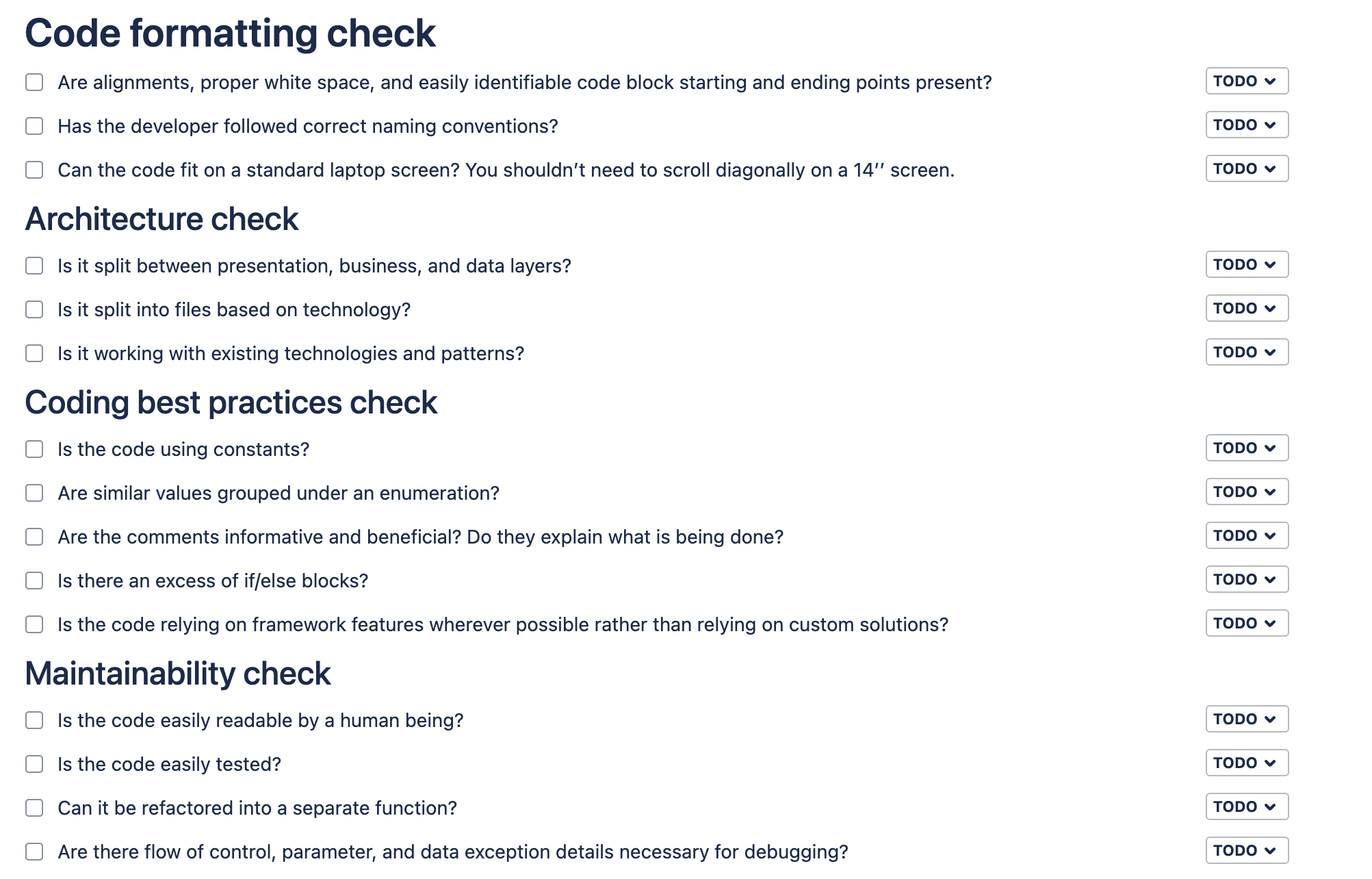
# Code formatting check
- Are alignments, proper white space, and easily identifiable code block starting and ending points present?
- Has the developer followed correct naming conventions?
- Can the code fit on a standard laptop screen? You shouldn’t need to scroll diagonally on a 14’’ screen.
## Architecture check
- Is it split between presentation, business, and data layers?
- Is it split into files based on technology?
- Is it working with existing technologies and patterns?
## Coding best practices check
- Is the code using constants?
- Are similar values grouped under an enumeration?
- Are the comments informative and beneficial? Do they explain what is being done?
- Is there an excess of if/else blocks?
- Is the code relying on framework features wherever possible rather than relying on custom solutions?
## Maintainability check
- Is the code easily readable by a human being?
- Is the code easily tested?
- Can it be refactored into a separate function?
- Are there flow of control, parameter, and data exception details necessary for debugging?
- Are configurable files kept in place? There must not be a need to make changes if the data changes frequently.
## Reusability check
- Are the same principles not repeated more than once?
- Are reusable services and functions used when applicable?
## Security check
- Validation against SQL injections
- Validation against XSS
- Is sensitive data encrypted?
## Scalability check
- Is the code scalable?
## Useability check
- Is the solution usable from the user’s POV?
## Performance check
- Is the correct data type used?
- Lazy loading, asynchronous and parallel processing
- Caching and session/application data
DoD (Definition of Done) Template
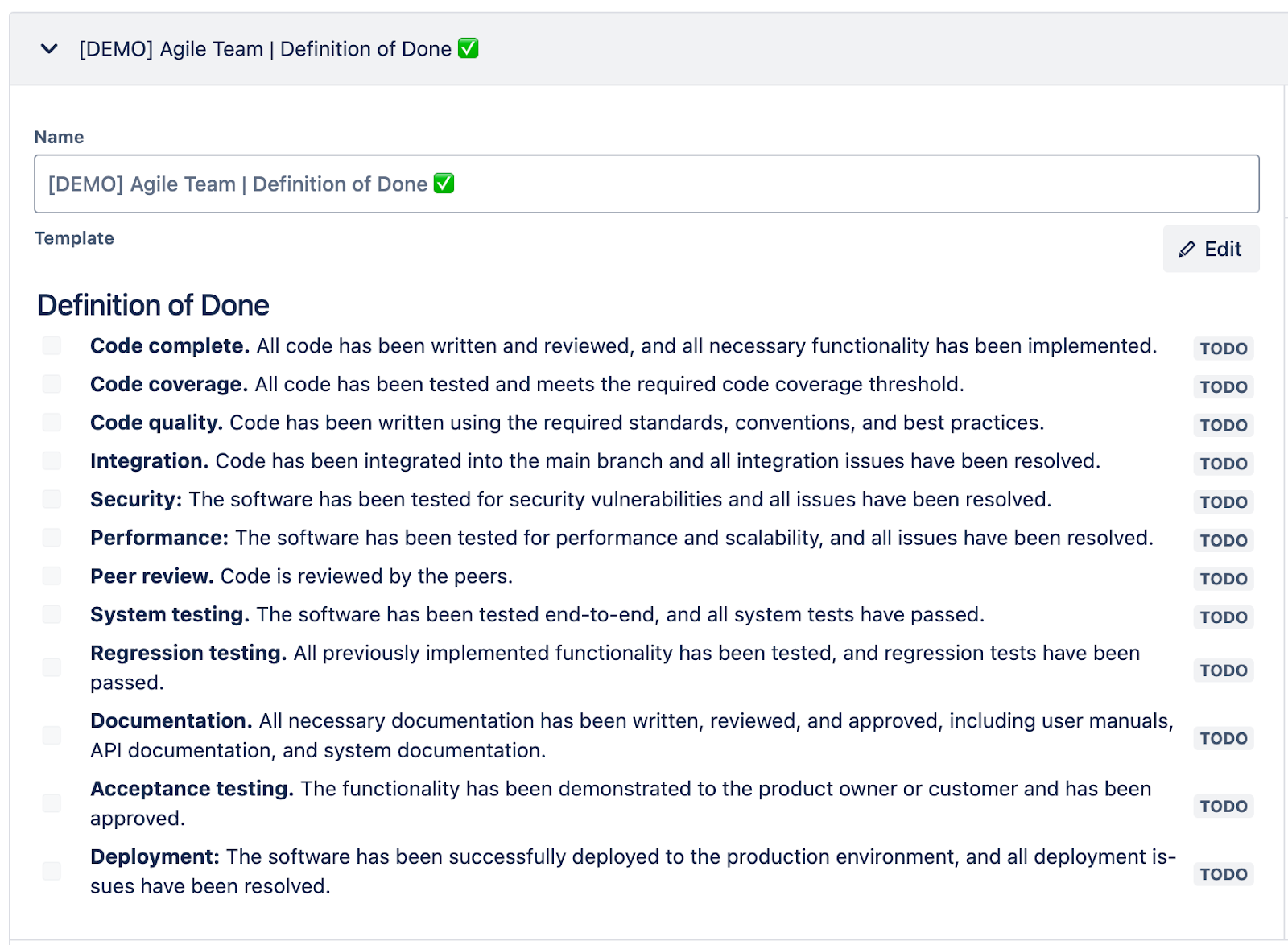
## Definition of Done
-**Code complete.** All code has been written and reviewed, and all necessary functionality has been implemented.
-**Code coverage.** All code has been tested and meets the required code coverage threshold.
-**Code quality.** Code has been written using the required standards, conventions, and best practices.
-**Integration.** Code has been integrated into the main branch, and all integration issues have been resolved.
-**Security:** The software has been tested for security vulnerabilitie,s and all issues have been resolved.
-**Performance:** The software has been tested for performance and scalability, and all issues have been resolved.
-**Peer review.** The code is reviewed by the peers.
-**System testing.** The software has been tested end-to-end, and all system tests have passed.
-**Regression testing.** All previously implemented functionality has been tested, and regression tests have been passed.
-**Documentation.** All necessary documentation has been written, reviewed, and approved, including user manuals, API documentation, and system documentation.
-**Acceptance testing.** The functionality has been demonstrated to the product owner or customer and has been approved.
-**Deployment:** The software has been successfully deployed to the production environment, and all deployment issues have been resolved.
Management Team
OKRs Template
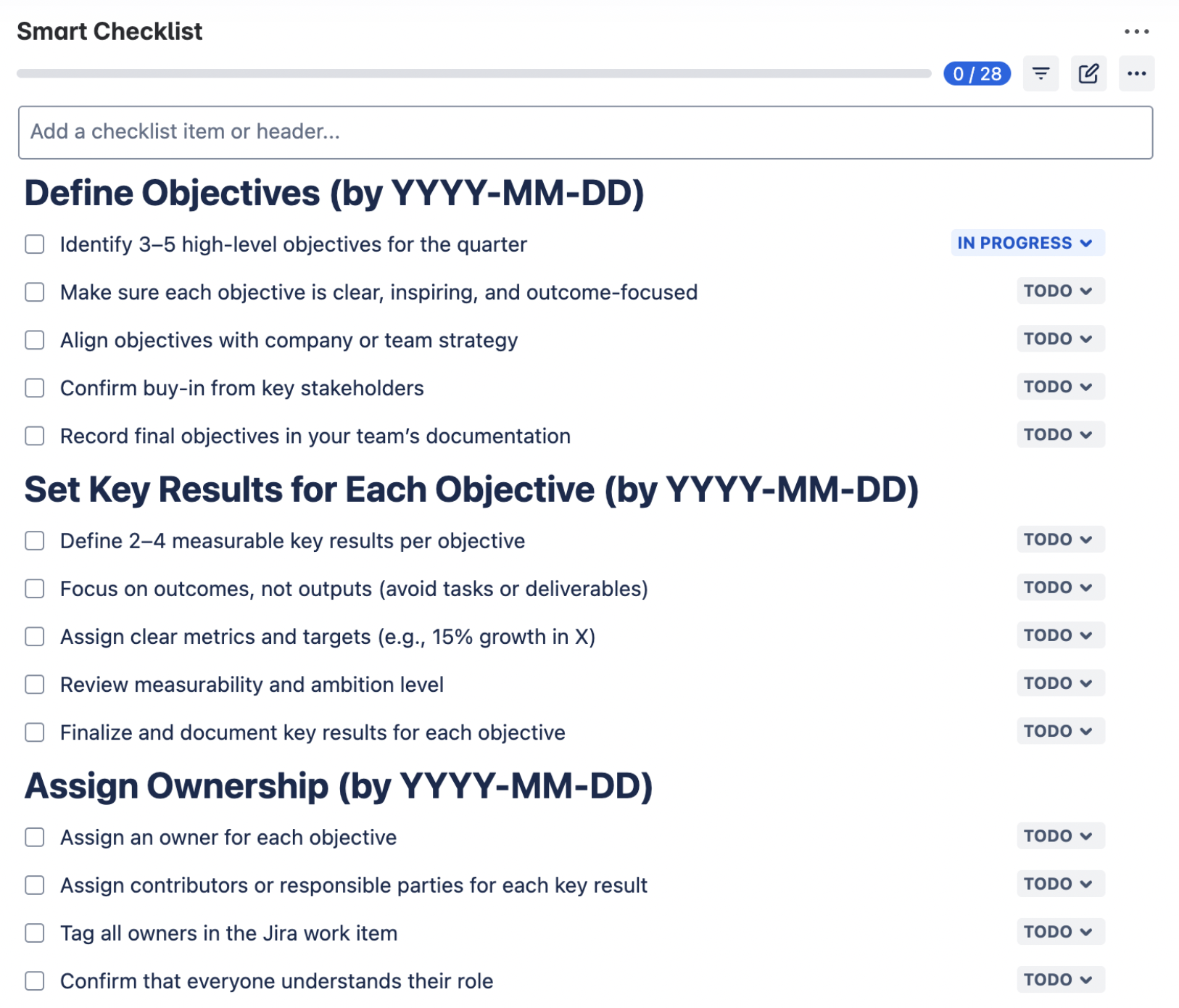
## **Define Objectives (by YYYY-MM-DD)**
- Identify 3–5 high-level objectives for the quarter
- Ensure each objective is clear, inspiring, and outcome-focused
- Align objectives with company or team strategy
- Confirm buy-in from key stakeholders
- Record final objectives in your team’s documentation
## **Set Key Results for Each Objective (by YYYY-MM-DD)**
- Define 2–4 measurable key results for each objective
- Focus on outcomes, not outputs (avoid tasks or deliverables)
- Assign clear metrics and targets (e.g., 15% growth in X)
- Review measurability and ambition level
- Finalize and document key results for each objective
## **Assign Ownership (by YYYY-MM-DD)**
- Assign an owner for each objective
- Assign contributors or responsible parties for each key result
- Tag all owners in the Jira work item
- Confirm that everyone understands their role
## **Review and Align With Stakeholders (by YYYY-MM-DD)**
- Schedule an OKRs review session
- Walk through all objectives and key results with the team
- Collect feedback and adjust if needed
- Mark final approval and share across relevant channels
## **Set Check-In Schedule and Track Progress**
- Choose the check-in frequency (weekly/bi-weekly)
- Add check-in dates to calendar or project tracker
- Define a method for tracking progress (manual, automated, etc.)
- Clarify how progress will be reported (e.g., checklist status, custom fields)
- Share check-in expectations with the team
## **Track Progress on Key Result: [Insert KR Title Here]**
- Define success criteria and baseline metrics
- Break down the key result into actionable steps
- Assign responsibilities and deadlines for each step
- Add links to relevant documents, dashboards, or data sources
- Start implementation
- Log weekly check-in notes or blockers
- Adjust plan or targets if needed
- Mark each sub-step as completed
- Review progress against targets by YYYY-MM-DD
- Document outcome and score the key result
- Add insights and improvement notes for the next cycle
## **Close and Evaluate at End of Period (by YYYY-MM-DD)**
- Review each objective and its key results
- Score each key result based on completion and impact
- Document lessons learned and improvement ideas
- Archive the checklist or move it to a “Completed OKRs” section
- Use insights to inform planning for the next cycle
Stakeholders Annual Report
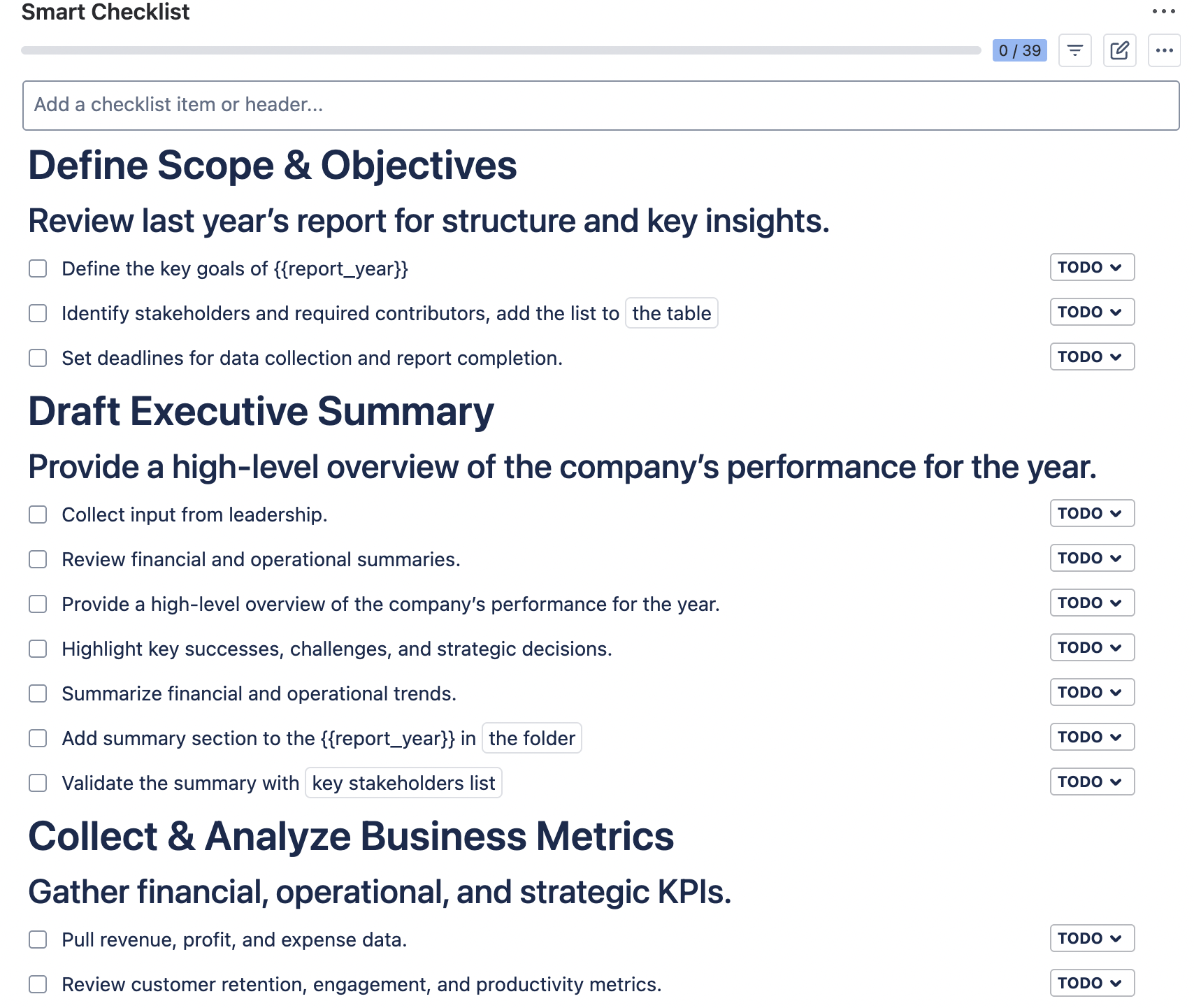
# Define Scope & Objectives
## Review last year’s report for structure and key insights.
- Define the key goals of {{report_year}}
- Identify stakeholders and required contributors, add the list to [the table](https://docs.google.com/sheets/)
- Set deadlines for data collection and report completion.
# Draft Executive Summary
## Provide a high-level overview of the company’s performance for the year.
- Collect input from leadership.
- Review financial and operational summaries.
- Provide a high-level overview of the company’s performance for the year.
- Highlight key successes, challenges, and strategic decisions.
- Summarize financial and operational trends.
- Add summary section to the {{report_year}} in [the folder](https://drive.google.com/drive/folders/1114)
- Validate the summary with [key stakeholders list](https://docs.google.com/sheets/)
# Collect & Analyze Business Metrics
## Gather financial, operational, and strategic KPIs.
- Pull revenue, profit, and expense data.
- Review customer retention, engagement, and productivity metrics.
- Prepare data visualization (charts & tables)
- Save data in [the folder](https://drive.google.com/drive/folders/1111)
- Add analysis section to the {{report_year}} in [the folder](https://drive.google.com/drive/folders/1114)
# Summarize Strategic Initiatives
## Document key projects and initiatives from the past year and their business impact.
- Identify the top 3-5 initiatives with measurable impact.
- Validate business outcomes with project owners.
- Create a summary of achievements with supporting data.
- Add relevant section to the {{report_year}} in [the folder](https://drive.google.com/drive/folders/1114)
# Document Key Challenges & Insights
## Identify major obstacles encountered during the year.
- Gather feedback from stakeholders on challenges faced.
- Save feedback notes for {{report_year}} in [the folder](https://drive.google.com/drive/folders/1113)
- Document process inefficiencies and corrective actions.
- Suggest improvements for next year.
- Add relevant section to the {{report_year}} in [the folder](https://drive.google.com/drive/folders/1114)
# Define Future Objectives
## Establish 3-5 strategic goals for the upcoming year.
- Define SMART objectives (Specific, Measurable, Achievable, Relevant, Time-bound).
- Identify resources needed for goal execution.
- Assign accountability to key teams.
- Add relevant section the {{report_year}} in [the folder](https://drive.google.com/drive/folders/1114)
# Collect & Incorporate Stakeholder Feedback
## Review input from investors, executives, and employees.
- Conduct stakeholder feedback sessions.
- Save recordings in [the folder](https://drive.google.com/drive/folders/1114)
- Document suggestions and key takeaways.
- Incorporate relevant insights into the final {{report_year}} in [the folder](https://drive.google.com/drive/folders/1114)
# Compile Supporting Evidence
## Attach relevant financial reports, project summaries, and performance data.
- Validate all data sources for accuracy.
- Attach visual reports (dashboards, charts, etc.).
- Review attachments for completeness.
- Save all data in [the folder](https://drive.google.com/drive/folders/1114)
# Conduct Final Review & Submit Report
## Review the full report for consistency and accuracy.
- Validate report with key stakeholders - [list](https://railsware.slack.com/files/1111)
- Obtain necessary approvals.
- Distribute report [to relevant parties](https://docs.google.com/sheets/)
Operations Team
Vendor Evaluation Template
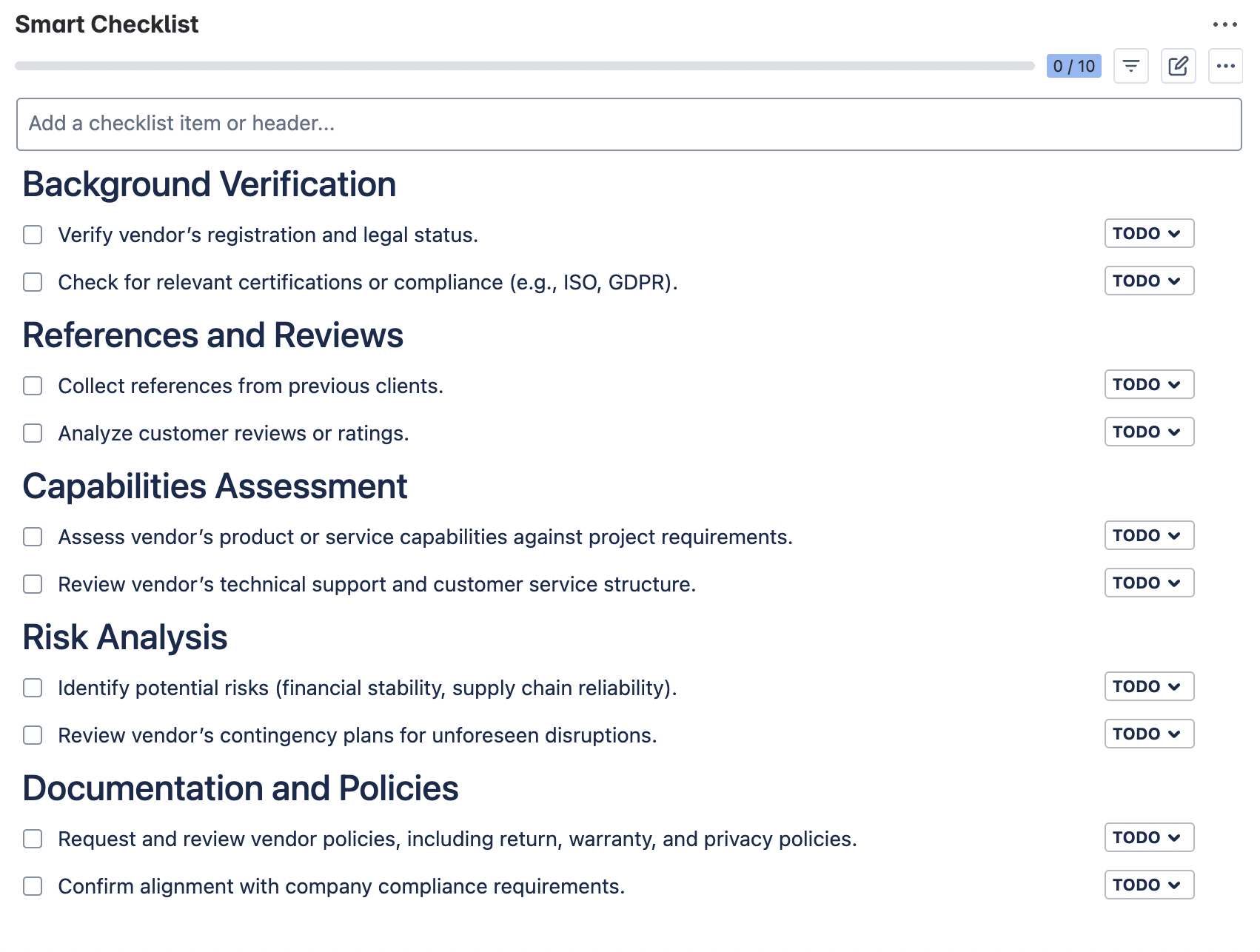
## Background Verification
- Verify vendor’s registration and legal status.
- Check for relevant certifications or compliance (e.g., ISO, GDPR).
## References and Reviews
- Collect references from previous clients.
- Analyze customer reviews or ratings.
## Capabilities Assessment
- Assess vendor’s product or service capabilities against project requirements.
- Review vendor’s technical support and customer service structure.
## Risk Analysis
- Identify potential risks (financial stability, supply chain reliability).
- Review vendor’s contingency plans for unforeseen disruptions.
## Documentation and Policies
- Request and review vendor policies, including return, warranty, and privacy policies.
- Confirm alignment with company compliance requirements.
Business Travel Management Template
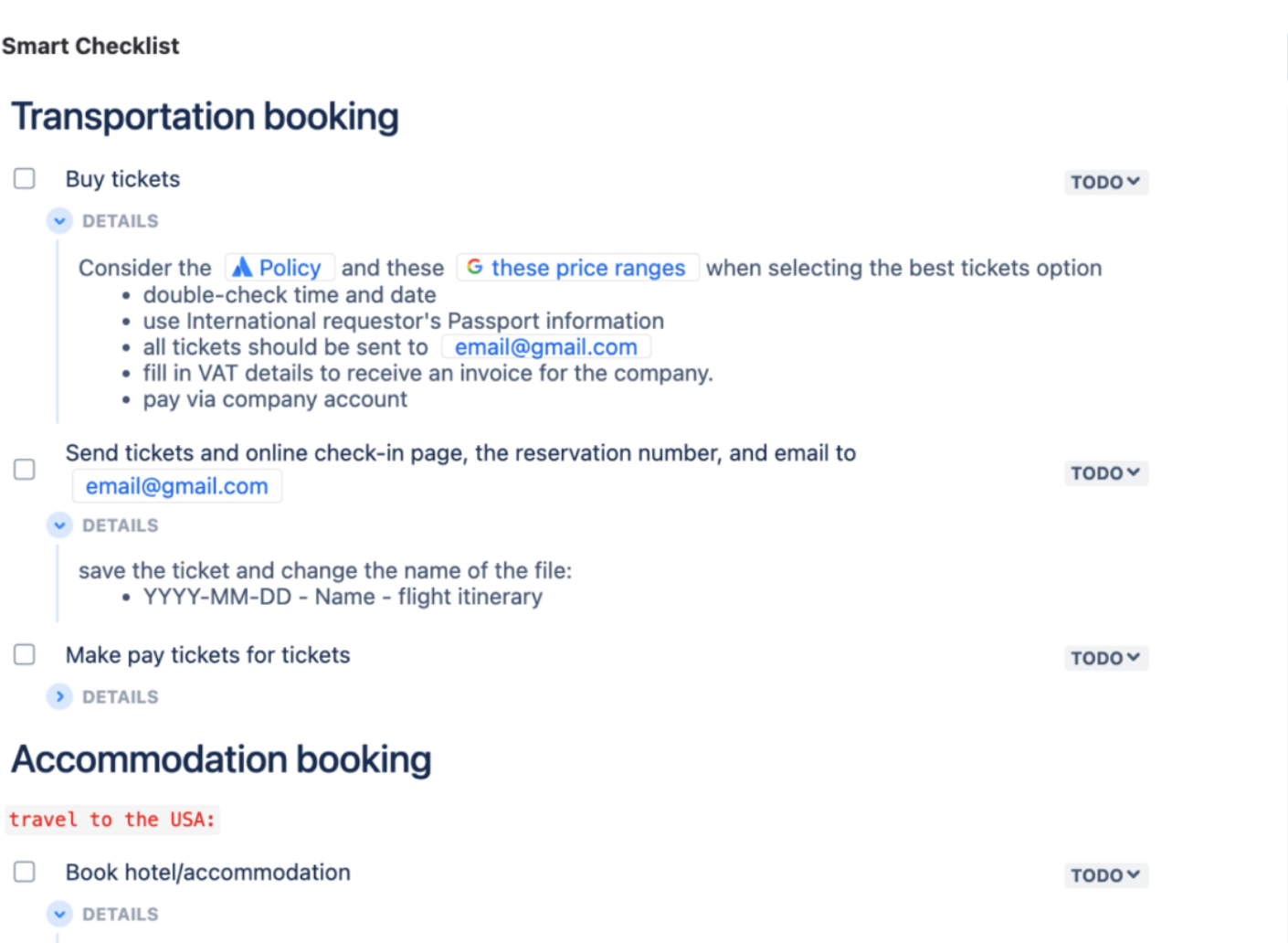
# Ticket structure
– Link this process to the Support Help ticket as `caused by`
– Link this process to [Travel Epic](https://jira.atlassian.com/) as `included in` to have all travel processes in one place
# Check the submitted travel preferences first
– Collect and review submitted travel preferences submitted through the [helpdesk](https://confluence.atlassian.com/servicedesk/)
> – Tickets land in Slack in #travel-help
> – It’s preferable to communicate and clarify all details in comments in the Help ticket so that someone else can continue the process if you can’t do this.
– Check if everything is okay with [docs](https://drive.google.com/drive) (e.g. passport is valid)
– Check if the request is within the budget [here](https://lookerstudio.google.com/)
> – Policy: Business Travel
> – Data range: This year
– If needed, provide visa support
> Use **Support** Smart Checklist Template to proceed
– Research options for accommodation and transportation based on submitted preferences and dates of the trip
– Set up a call or communicate asynchronously to confirm travel dates, accommodation, and transportation options before booking
# Daily Allowance
– By referring to the [policy](https://confluence.atlassian.com/), calculate how much the daily allowance, taxi, and other expenses related to the business trip would cost
– Submit a [coverage ticket](https://jira.atlassian.com/)
# Price research
– Algorithm of the research in detail
>* Check on dedicated search sites
>* Re-check on aggregators
>* Check exact flights directly with the flight company
– Dedicated search sites
>* google.com/flght
>* kayak.com
>* http://skyscanner.com
– Aggregators
>* mytickets.ae
>* kiwi.com
>* orbitz.com
>* expedia.com
>* anywayanyday.com
– Search for the best ticket options that we already use
> * [LOT](https://www.lot.com/ua/en/)
> * [Wizzair](https://wizzair.com/#/)
> * [Ryanair](https://www.ryanair.com/us/en)
# Transportation booking
– Buy tickets
> Consider the [policy](https://confluence.atlassian.com/policy) and [these price ranges](https://docs.google.com/spreadsheets/) when selecting the best tickets option
> * Double-check time and date
> * Use the requestor’s international passport information
> * All tickets should be sent to email@company.com
> * Fill in VAT details to receive an invoice for the company.
> * Pay via company account
– Send tickets and online check-in page, the reservation number, and email to email@company.com
> Save the ticket and change the name of the file:
> – YYYY-MM-DD – Name – flight itinerary
– Make pay tickets for tickets
> Add step-by-step instructions
# Accommodation booking
`Travel to the USA:`
– Book hotel/accommodation
> – If a person is attending a conference, check with the event organizer for any partner hotels offering special offers or discounts.
– After receiving the booking confirmation, follow up with a phone call to the hotel to ensure that the hotel has charged the card on file for the entire duration of the trip.
`Travel to any other location:`
– Go to **Airbnb**
> * Login with our credentials
> * Choose English and USD currency
> * Choose the city, dates, and number of people
> * Open filters and select:
>> Entire place
>> Apartment
>> Instant book
>> Self check-in (preferable)
>> Free cancellation (preferable)
> * Choose an apartment within our budget and that follows our policy and align it with the submitted preferences
– Book the apartment
> * Check dates and number of people
> * Choose “Work trip”
> * Choose “Book this place for someone else”
> * Insert email address and press **Add**
> * if a requestor is not on the list, they must create an Airbnb account*
> * Press **Save**
> * Choose/indicate payment method and billing details if needed
> * Pay via company credit card; it’s indicated in the process description.
> * Check cancellation policy once again
> * Confirm and pay
– If Airbnb is not available, use Booking.com
– Instructions for **Booking.com**
> * Login with our credentials
> * Choose English and USD currency
> * Choose the hotel or apartment for the needed dates that fit the budget in the policy and align with the submitted preferences
> * Proceed to booking
> * Provide the requestor’s details to the booking
> * In the special request text block, ask about the invoice. Also, choose “I would like an invoice for my company at check-out.”
> * Pay via company credit card; it’s indicated in the process description
– Make pay tickets for lodging booking
– Insert pay tickets into the ticket’s description or in the comments
# City Tax
If the trip is to a European country, the hotel may charge a [City tax](https://visitukraine.today/blog/2616/which-countries-have-introduced-tourist-taxes-and-fees). It is paid at the hotel.
– Need to raise a Refund ticket
# Provide the requestor with all the needed info before arrival
– Share the travel itinerary with the requestor via email or Slack
– Send a link for a check-in, remind to check in in advance online
> Every Airline has a different link for check-in; find it on the airline website
– Provide lodging booking details and notify that the apartment is booked; they will communicate with the host on their own
– Share your personal number, and Telegram/WhatsApp for the requestor to contact you for any reason
# Upon Arrival
– Check if a person checked in to the hotel/apartment
– Check if no extra charges were applied
– Remind them of the check-out time and provide check-out guidelines
## For office visitors
– Show the office to them
> For office visitors – share the [guide](https://drive.google.com/drive)
– Provide them with the wi-fi access and make sure that it works properly
– Show the desk they can use
– Provide them with any [tech equipment if needed](https://confluence.atlassian.com/servicedesk/)
– On the 1st day, take the requestor for lunch and/or dinner, and/or organize a group of team members to go for lunch or dinner together
– Suggest places to visit and see while in the city
>* See [this guide](https://drive.google.com/drive) to get local tips on what places to visit, where to eat, and other important stuff
# Before Departure
– Remind about the departure date and time
– Collect an access card
– Advise to arrive at the airport at least 2 hours before departure time
# Feedback
– Ask to provide inputs and feedback at this [link](https://docs.google.com/forms)
Human Resources Team
Position Opening Template
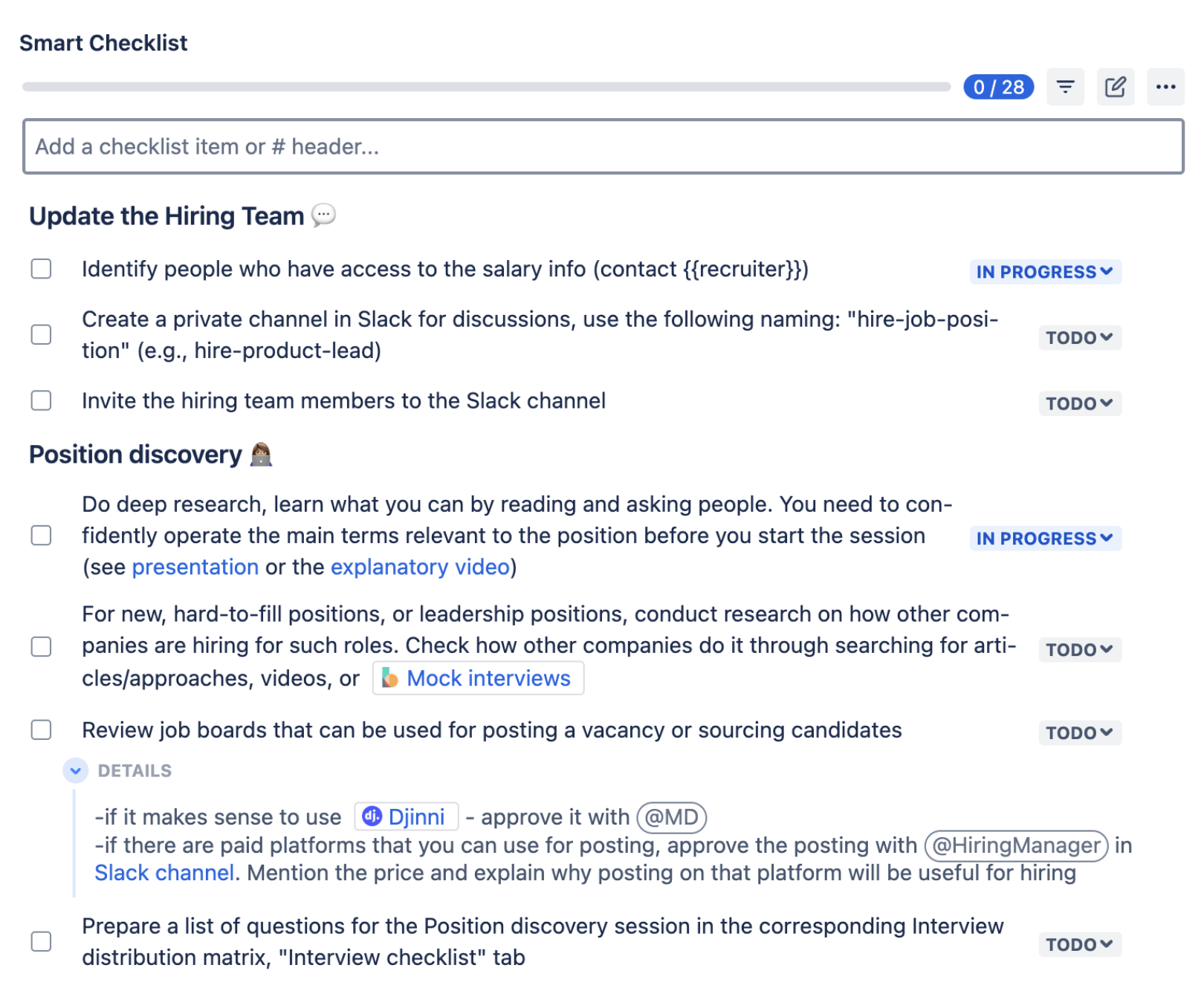
### Update the Hiring Team
- Identify people who have access to the salary info (contact {{recruiter}})
- Create a private channel in Slack for discussions, use the following naming: “hire-job-position” (e.g., hire-product-lead)
- Invite the hiring team members to the Slack channel
### Position discovery
- Do deep research, learn what you can by reading and asking people. You need to confidently operate the main terms relevant to the position before you start the session (see [presentation] or the [explanatory video])
- For new, hard-to-fill positions, or leadership positions, conduct research on how other companies are hiring for such roles. Check how other companies do it through searching for articles/approaches, videos, or [Mock interviews](https://www.thebalancemoney.com/how-to-use-mock-interviews-to-practice-interviewing-2061626)
- Review job boards that can be used for posting a vacancy or sourcing candidates
> -if it makes sense to use [Djinni](https://djinni.co/developers/) - approve it with @MD
> -if there are paid platforms that you can use for posting, approve the posting with @HiringManager in [Slack channel]. Mention the price and explain why posting on that platform will be useful for hiring
- Prepare a list of questions for the Position discovery session in the corresponding Interview distribution matrix, “Interview checklist” tab
- Schedule the Position discovery session (1-3h, depending on the role). If the team cannot come up with the list of projects, schedule +1h.
### Job Description
- Prepare a job description using [this guide](insert your link)
- Define job title, responsibilities, and requirements
- Outline key qualifications, skills, and experience needed
- Include salary range and benefits (if applicable)
- Approve the JD draft with the hiring team. Ask them to review the structure and content, NOT the grammar
- Review the JD draft with the @ContentWriter
### Vacancy posting
- Post on the company website
- Post on job boards (LinkedIn, Indeed, etc.)
- Post on social media channels
- Post internal referrals and employee networks
- Add vacancy to the applicant tracking system (ATS)
### Tracking & Follow-up
- Monitor application responses
- Ensure compliance with equal opportunity policies
- Review applications against job requirements
- Filter out unqualified candidates
- Prioritize top candidates for further evaluation
### Candidate Screening & Shortlisting
- Consult hiring managers for input on top candidates
- Prepare a structured shortlist (e.g., top 5–10 candidates)
- Notify shortlisted candidates and schedule interviews
- Send rejection emails to unqualified candidates
Onboarding Template
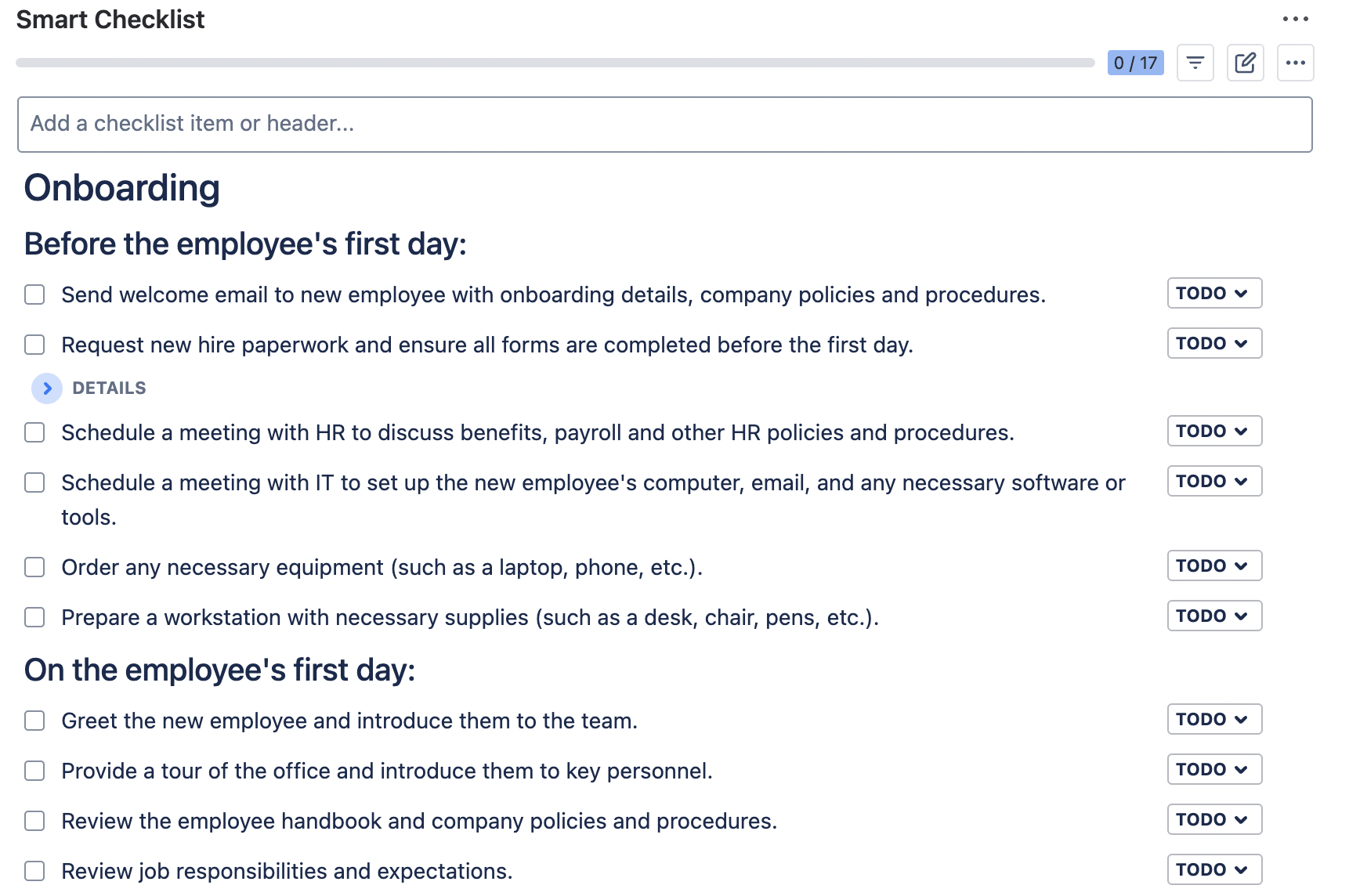
## Onboarding
### Before the employee’s first day:
- Send welcome email to new employee with onboarding details, company policies and procedures.
- Request new hire paperwork and ensure all forms are completed before the first day.
> (Employment agreement, NDA, Data processing agreement)
- Schedule a meeting with HR to discuss benefits, payroll and other HR policies and procedures.
- Schedule a meeting with IT to set up the new employee’s computer, email, and any necessary software or tools.
- Order any necessary equipment (such as a laptop, phone, etc.).
- Prepare a workstation with necessary supplies (such as a desk, chair, pens, etc.).
### On the employee’s first day:
- Greet the new employee and introduce them to the team.
- Provide a tour of the office and introduce them to key personnel.
- Review the employee handbook and company policies and procedures.
- Review job responsibilities and expectations.
- Review any necessary training and development opportunities.
### During the first week:
- Schedule check-ins with the new employee to answer any questions and provide support.
- Set up any necessary meetings with team members or managers.
- Review the new employee’s progress and ensure they have the necessary tools and resources to be successful.
### During the first 30 days:
- Provide ongoing feedback and support to the new employee.
- Schedule a review meeting with the new employee to discuss progress and any necessary adjustments to job responsibilities or expectations.
- Conduct a 30-day performance review and discuss any areas for improvement or growth opportunities.
Marketing Team
Email Campaign Template
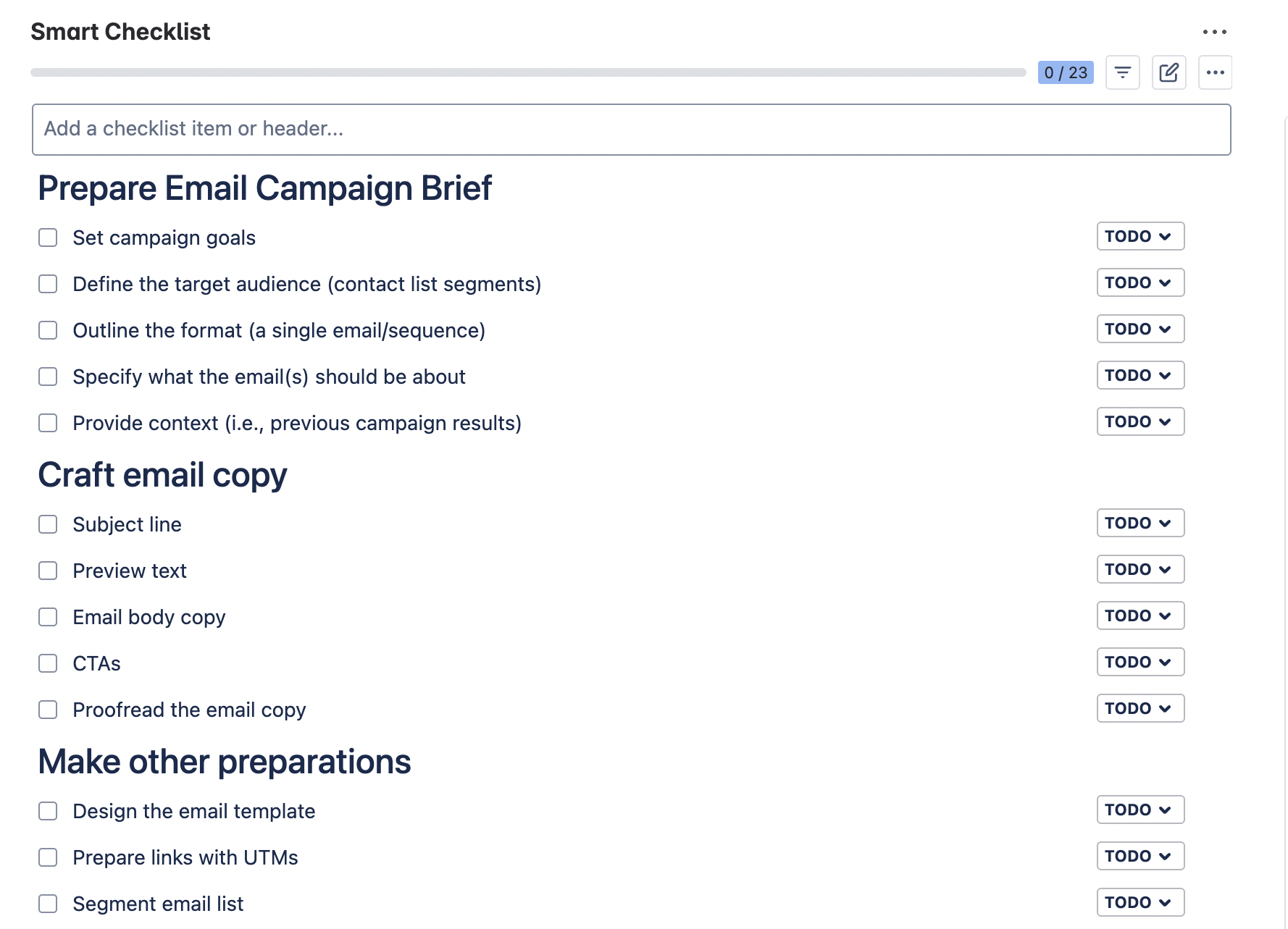
## Prepare Email Campaign Brief
- Set campaign goals
- Define the target audience (contact list segments)
- Outline the format (a single email/sequence)
- Specify what the email(s) should be about
- Provide context (i.e., previous campaign results)
## Craft email copy
- Subject line
- Preview text
- Email body copy
- CTAs
- Proofread the email copy
## Make other preparations
- Design the email template
- Prepare links with UTMs
- Segment email list
## Test the email and launch the campaign
- Conduct testing on various platforms
- Verify mobile responsiveness
- Set A/B testing parameters
- Schedule email send-out
## Analyze results
- Monitor the KPIs
- Check open and click-through rates
- Check the A/B testing results
- Switch to the best-performing option
- Send follow-up or reminder emails
- Prepare a campaign report
SEO Research Template
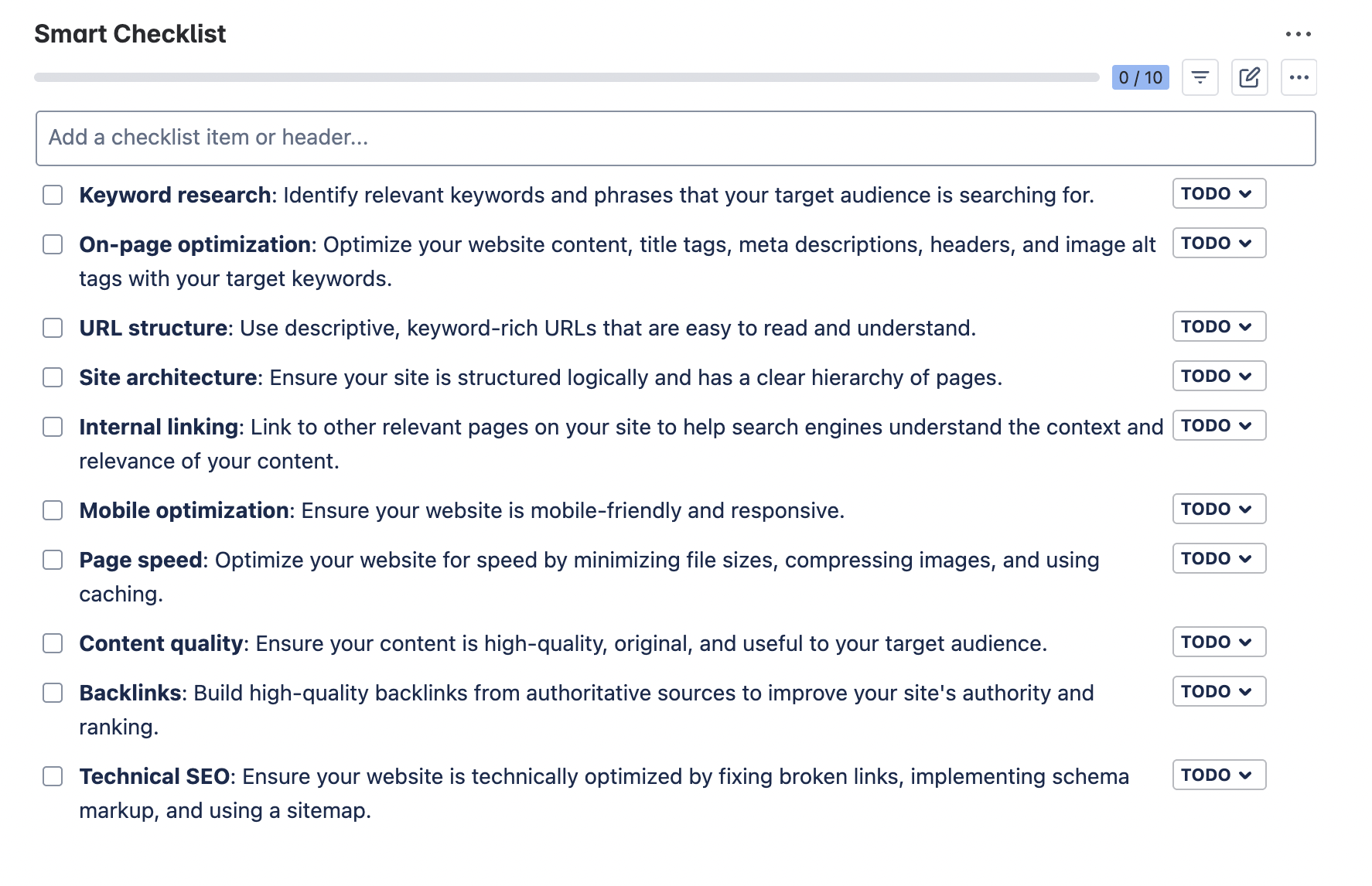
- **Keyword research**: Identify relevant keywords and phrases that your target audience is searching for.
- **On-page optimization**: Optimize your website content, title tags, meta descriptions, headers, and image alt tags with your target keywords.
- **URL structure**: Use descriptive, keyword-rich URLs that are easy to read and understand.
- **Site architecture**: Ensure your site is structured logically and has a clear hierarchy of pages.
- **Internal linking**: Link to other relevant pages on your site to help search engines understand the context and relevance of your content.
- **Mobile optimization**: Ensure your website is mobile-friendly and responsive.
- **Page speed**: Optimize your website for speed by minimizing file sizes, compressing images, and using caching.
- **Content quality**: Ensure your content is high-quality, original, and useful to your target audience.
- **Backlinks**: Build high-quality backlinks from authoritative sources to improve your site’s authority and ranking.
- **Technical SEO**: Ensure your website is technically optimized by fixing broken links, implementing schema markup, and using a sitemap.